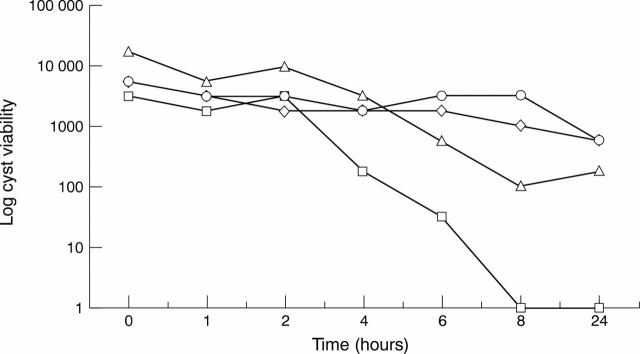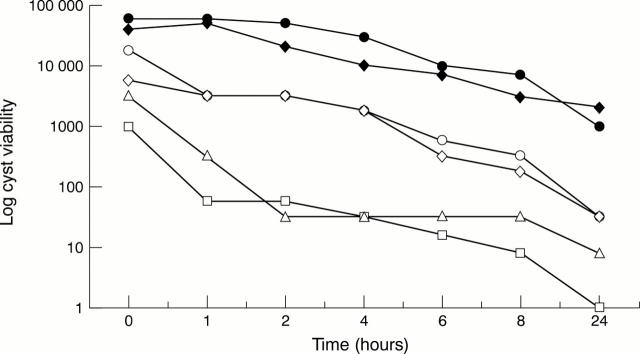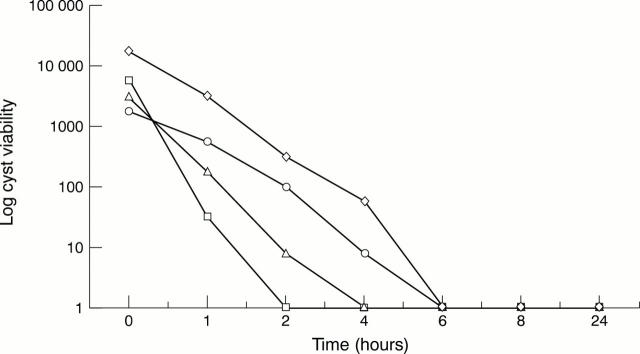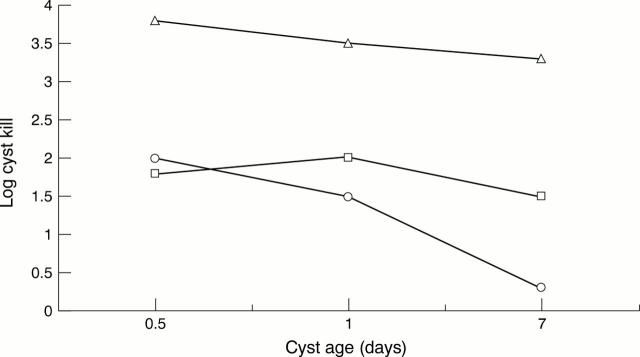Abstract
AIMS—(i) To determine effect of Acanthamoeba cyst age, method of production, and (ii) to assay technique on the efficacy of multipurpose solutions (MPS) and hydrogen peroxide based contact lens disinfectants. (iii) To establish if MPS can remove mature cysts from contact lenses according to the ISO/DIS 14729 regimen test for microbe removal. METHODS—Immature and mature cysts of A polyphaga were tested against the MPS Opti-Free express and the hydrogen peroxide based solutions Oxysept 1Step and Oxysept 1 using two assay methods. Simulated patient regimen testing was performed with the Opti-Free express and Complete using mature cysts inoculated on to group I or group IV lenses. RESULTS—Immature cysts were sensitive to disinfection by all solutions. No killing was observed with mature cysts with Opti-Free express, while immature cysts yielded a 1-2 log reduction in viability. Oxysept 1Step gave a 1.1 (SD 0.3) log reduction in mature cysts after 6 hours. Oxysept 1 gave a 2.4 (0.3) log reduction in mature cysts after 4 hours and a 3.8 (0.5) log reduction after 6 hours. Patient regimen testing using Opti-Free express and Complete resulted in no recovery of viable mature cysts from the contact lenses or from the soaking solutions. CONCLUSION—Cyst age but not method of production used in this study influences the efficacy of contact lens disinfectants against Acanthamoeba. MPS are effective in removing cysts from contact lens surfaces and may have a role in the prevention of acanthamoeba keratitis.
Full Text
The Full Text of this article is available as a PDF (146.2 KB).
Figure 1 .
Efficacy of multipurpose solution Opti-Free express against Acanthamoeba polyphaga (ATCC 308730) cysts. Square = Neff 0.5 day; triangle = Neff 1 day; circle = Neff 7 day; diamond = NNA-E coli.
Figure 2 .
Efficacy of hydrogen peroxide system Oxysept 1Step against Acanthamoeba polyphaga (ATCC 308730) cysts. Microtitre plate assay. Open square = Neff 0.5 day; open triangle = Neff 1 day; open circle = Neff 7 day; open diamond = NNA-E coli. Agar overlay plaque assay: solid circle Neff 7 day; solid diamond NNA-E coli).
Figure 3 .
Efficacy of hydrogen peroxide system Oxysept 1 against Acanthamoeba polyphaga (ATCC 308730) cysts. Square = Neff 0.5 day; triangle = Neff 1 day; circle = Neff 7 day; diamond = NNA-E coli.
Figure 4 .
Effect of cyst age (Neff's medium prepared) on efficacy of Oxysept 1 (triangle), Oxysept 1Step (square), and Opti-Free express(circle) disinfectants after 6 hours of exposure.
Selected References
These references are in PubMed. This may not be the complete list of references from this article.
- Anger C., Rupp D., Pomrenke M., Kapadia S. A quantitative bacterial plaque assay for the enumeration of viable Acanthamoeba cells. Rev Infect Dis. 1991 Mar-Apr;13 (Suppl 5):S396–S396. doi: 10.1093/clind/13.supplement_5.s396. [DOI] [PubMed] [Google Scholar]
- Bottone E. J., Madayag R. M., Qureshi M. N. Acanthamoeba keratitis: synergy between amebic and bacterial cocontaminants in contact lens care systems as a prelude to infection. J Clin Microbiol. 1992 Sep;30(9):2447–2450. doi: 10.1128/jcm.30.9.2447-2450.1992. [DOI] [PMC free article] [PubMed] [Google Scholar]
- Buck S. L., Rosenthal R. A. A quantitative method to evaluate neutralizer toxicity against Acanthamoeba castellanii. Appl Environ Microbiol. 1996 Sep;62(9):3521–3526. doi: 10.1128/aem.62.9.3521-3526.1996. [DOI] [PMC free article] [PubMed] [Google Scholar]
- Buck S. L., Rosenthal R. A., Abshire R. L. Amoebicidal activity of a preserved contact lens multipurpose disinfecting solution compared to a disinfection/neutralisation peroxide system. Cont Lens Anterior Eye. 1998;21(3):81–84. doi: 10.1016/s1367-0484(98)80027-1. [DOI] [PubMed] [Google Scholar]
- Gray T. B., Cursons R. T., Sherwan J. F., Rose P. R. Acanthamoeba, bacterial, and fungal contamination of contact lens storage cases. Br J Ophthalmol. 1995 Jun;79(6):601–605. doi: 10.1136/bjo.79.6.601. [DOI] [PMC free article] [PubMed] [Google Scholar]
- Hugo E. R., McLaughlin W. R., Oh K. H., Tuovinen O. H. Quantitative enumeration of acanthamoeba for evaluation of cyst inactivation in contact lens care solutions. Invest Ophthalmol Vis Sci. 1991 Mar;32(3):655–657. [PubMed] [Google Scholar]
- John T., Desai D., Sahm D. Adherence of Acanthamoeba castellanii cysts and trophozoites to unworn soft contact lenses. Am J Ophthalmol. 1989 Dec 15;108(6):658–664. doi: 10.1016/0002-9394(89)90857-x. [DOI] [PubMed] [Google Scholar]
- Khunkitti W., Lloyd D., Furr J. R., Russell A. D. Acanthamoeba castellanii: growth, encystment, excystment and biocide susceptibility. J Infect. 1998 Jan;36(1):43–48. doi: 10.1016/s0163-4453(98)93054-7. [DOI] [PubMed] [Google Scholar]
- Kilvington S. Acanthamoeba trophozoite and cyst adherence to four types of soft contact lens and removal by cleaning agents. Eye (Lond) 1993;7(Pt 4):535–538. doi: 10.1038/eye.1993.116. [DOI] [PubMed] [Google Scholar]
- Kilvington S., Larkin D. F. Acanthamoeba adherence to contact lenses and removal by cleaning agents. Eye (Lond) 1990;4(Pt 4):589–593. doi: 10.1038/eye.1990.82. [DOI] [PubMed] [Google Scholar]
- Larkin D. F., Kilvington S., Easty D. L. Contamination of contact lens storage cases by Acanthamoeba and bacteria. Br J Ophthalmol. 1990 Mar;74(3):133–135. doi: 10.1136/bjo.74.3.133. [DOI] [PMC free article] [PubMed] [Google Scholar]
- Radford C. F., Bacon A. S., Dart J. K., Minassian D. C. Risk factors for acanthamoeba keratitis in contact lens users: a case-control study. BMJ. 1995 Jun 17;310(6994):1567–1570. doi: 10.1136/bmj.310.6994.1567. [DOI] [PMC free article] [PubMed] [Google Scholar]
- Radford C. F., Lehmann O. J., Dart J. K. Acanthamoeba keratitis: multicentre survey in England 1992-6. National Acanthamoeba Keratitis Study Group. Br J Ophthalmol. 1998 Dec;82(12):1387–1392. doi: 10.1136/bjo.82.12.1387. [DOI] [PMC free article] [PubMed] [Google Scholar]
- Silvany R. E., Dougherty J. M., McCulley J. P., Wood T. S., Bowman R. W., Moore M. B. The effect of currently available contact lens disinfection systems on Acanthamoeba castellanii and Acanthamoeba polyphaga. Ophthalmology. 1990 Mar;97(3):286–290. doi: 10.1016/s0161-6420(90)32590-3. [DOI] [PubMed] [Google Scholar]
- Stevenson R. W., Seal D. V. Has the introduction of multi-purpose solutions contributed to a reduced incidence of Acanthamoeba keratitis in contact lens wearers? A review. Cont Lens Anterior Eye. 1998;21(3):89–92. doi: 10.1016/s1367-0484(98)80029-5. [DOI] [PubMed] [Google Scholar]






